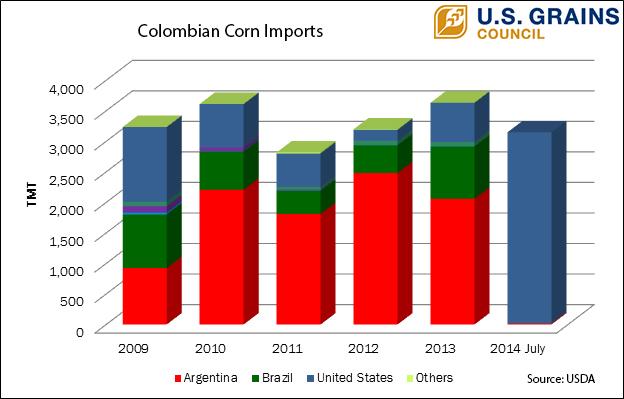The United States is on track to capture more than 95 percent of Colombia’s 3.6 million metric ton (141 million bushels) corn market this marketing year, which ends Aug. 31. This is a dramatic turn-around from 2013 exports of just 644,000 tons (25 million bushels) to that country.
Colombia has traditionally been the biggest importer of U.S. corn in South America. However, due to tariff advantages Colombian importers began switching to Argentina and Brazil to source their corn needs around 2009. It wasn’t until the U.S. – Colombia free trade agreement was implemented in 2012 that U.S. exporters began to become competitive once again in this vital corn market.
The FTA agreement allows 2.3 million tons (90 million bushels) of U.S. corn to be imported duty-free. The duty-free quota for this year was filled in June, after which market watchers expected Colombian importers to switch back to South American origin as the Argentine crop began to be exported.
However, this did not happen. The low international price of corn has caused Colombia to raise its duties on other origins to more than 30 percent, compared to 18 percent on corn from the United States. As a result, Colombian grain importers returned aggressively to buying U.S. corn.
“This year, Colombian importers were able to save millions of dollars in taxes by importing U.S. corn, said USGC Director of Global Strategies Kurt Shultz.
“We benefit as a result of years of negotiations over the free trade agreement,” Shultz said. “After all these years, it’s actually been really beneficial to the U.S. corn producer.”
In addition to corn, the Council is working with the livestock industry in Colombia to introduce DDGS, which face no import duties, into that market.
Click play to hear a full report from Shultz about the Council’s work to develop the market for U.S. corn and corn co-products in Colombia.
About The U.S. Grains Council
The U.S. Grains Council develops export markets for U.S. barley, corn, sorghum and related products including distiller’s dried grains with solubles (DDGS) and ethanol. With full-time presence in 28 locations, the Council operates programs in more than 50 countries and the European Union. The Council believes exports are vital to global economic development and to U.S. agriculture’s profitability. Detailed information about the Council and its programs is online at www.grains.org.

